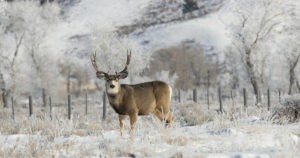Hunting and Fishing News & Blog Articles
To Feed Or Not To Feed. . . That Is The Question
 Photo credit: Getty Images
Photo credit: Getty Images
With the current temperature sitting at 0 and hitting a balmy high of 2 above today, I have to say that my concern for our big game herds is very real. The only solace I have is that for the last few weeks in my region, much of the snow melted off with some better temperatures. However, the cold streak we are experiencing now has iced things over, which will make it tough on the mule deer for the next week or more, even with the temperature on the rise.
This has produced a rise in deer feeding by Wyoming citizens. There is only one problem, a mule deer will struggle to digest much of the food offered at feeding stations. Wyoming Game and Fish sent out a notice to the Lander region about the issues mule deer face when fed forage that isn’t part of the natural landscape this time of year.
To quote one of the mule deer specific sections from the newsletter:
“Unlike elk, mule deer are highly selective foragers due to their specialized digestive system. Mule deer digestive systems contain specific bacteria that help break down only the plants they eat and are adapted to. The bacteria adjust slowly to match their diet through each season, and in the winter their gut contains the appropriate bacteria to digest only their winter diet of woody materials. Any human-provided food sources, including hay, apples, corn, etc. are simply not digestible and cause an abundance of lactic acid, acidosis, dehydration, and ultimately death. Fed mule deer often die from starvation with full stomachs of food they cannot digest.”
Also from the Wyoming Game and Fish Website:
“ Mule deer will likely still starve when fed in the winter. Mule deer are highly selective foragers, at least in part due to their specialized digestive system. Specific types of bacteria in their rumen are required to aid in the digestion of naturally occurring foods. Often, because their digestive system can’t adapt quickly enough, supplementally fed mule deer die with stomachs full of undigested feed. Supplemental feeding programs have been effective for other species like elk because their digestive systems are more adaptable to different kinds of forage.
Unpalatable foods include hay, corn, apples, birdseed, pumpkins, pelletized deer feed and any other foods that are not naturally in their browse diet this time of year. “The question then comes for many residents here in the Cowboy State, “How are other states feeding the deer?” Well that is a great question, it comes in the form of feed that is highly specific to mule deer and can be very difficult to distribute to the right regions. Many of Wyoming’s best mule deer winter range areas are closed down and distribution of food there is challenging at best and can add more stress to deer who have hunkered down there.
This is one I personally struggle with as to what we should do here in Wyoming. I have seen starving deer on ranches next to alfalfa piles personally and it makes me very sad that we will see many of the last two years’ crop of fawns likely no longer part of the landscape. What say you? Do we need to think about feeding programs or work or range improvement as a strategy?
The post To Feed Or Not To Feed. . . That Is The Question appeared first on Eastmans' Official Blog | Mule Deer, Antelope, Elk Hunting and Bowhunting Magazine | Eastmans' Hunting Journals.
Copyright
© Eastmans
